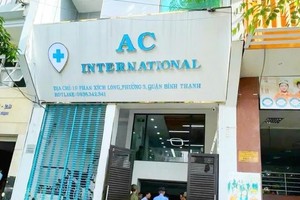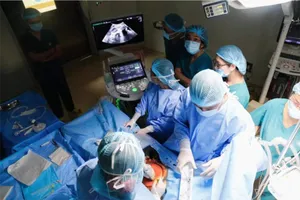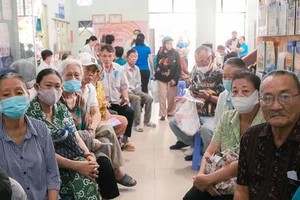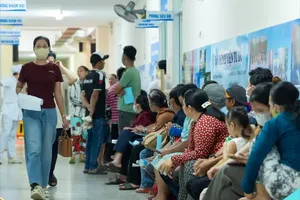 |
Medical staff of the Tam Anh Hospital carry out robotic surgery (Photo: SGGP) |
Private infirmaries also created a healthy competitive environment between public and private health systems in improving the quality of medical examination and treatment services for patients’ sake. However, it is still necessary to have policies and support mechanisms for private healthcare to develop more in the future.
The Xuyen A General Hospital in the gateway to the Northwest of Ho Chi Minh City has been one of the reliable addresses for medical examination and treatment for patients in Cu Chi, Hoc Mon outlying districts and the Southern Province of Tay Ninh over the years. On average, the hospital daily receives 2,000-2,500 outpatients and 1,000-1,500 inpatients.
Located in the western gateway, the Gia An 115 Hospital and the International City Hospital also admit local patients and those from the southwestern provinces. In particular, the Gia An 115 Hospital known for performing specialized techniques such as cardiology, Neurology - stroke, endocrinology, and orthopedic trauma was set up in the form of the public-private partnership (PPP) model between Hoa Lam Group and 115 People's Hospital. The hospital’s locally and abroad-trained medical workers and leading experts from the People's Hospital 115 have contributed to greatly reducing the load on big hospitals in the inner city.
Particularly, during the outbreak of the Covid-19 epidemic in Ho Chi Minh City a few years ago, privately-owned hospitals such as Hoan My Thu Duc General Hospital, Saigon South, Xuyen A, Gia An 115 have converted into a hospital to receive Covid-19 patients. Thankfully, thousands of patients received timely treatment, making a great contribution to reducing the burden on public health facilities. Medical workers of non-public infirmaries have also administered Covid-19 vaccines to thousands of people.
During the intense development of the epidemic, the number of severe Covid-19 patients were constantly increasing, private institution owners have not hesitated to invest in machinery and equipment such as ventilators, negative pressure isolation rooms, ECMO system as well as establish Covid-19 resuscitation centers to promptly treat patients.
In addition to contribution to the city’s fight against the Covid-19 epidemic and reduction of patient overload for large facilities, private hospitals are also attracting foreign patients and developing medical tourism. For example, the City International Hospital yearly admits more and more foreigners mainly foreigners living and working in Ho Chi Minh City and foreigners from Cambodia and Laos.
Set up later, the Tam Anh General Hospital has been emerging as a good facility in Ho Chi Minh City when it has invested in both service quality and intensive development. The hospital not only purchased much modern medical equipment but also attracted many leading experts in various fields and established specialized centers.
According to Associate Professor Tang Chi Thuong, Director of the Department of Health of Ho Chi Minh City, the city currently has 66 private hospitals and more than 7,800 private polyclinics. The private healthcare sector has made many contributions to the overall development of the city; most importantly, they have been helping to reduce the burden on the public health system’s patient overload.
Recently, the private healthcare system has undergone transformations in terms of quality, focusing on developing specialized healthcare, said Associate Professor Tang Chi Thuong. In the past, private hospitals transferred most serious patients to public hospitals for treatment, now private hospitals are confident to keep patients for treatment. This will pave the way for private hospitals’ competitiveness with public hospitals.
However, the proportion of private hospitals is presently still very small, accounting for only 10 percent of the total number of hospital beds in the city. In developed countries such as Japan, Korea, and Singapore, the private healthcare system accounts for more than 50 percent of the total number of hospital beds, which shows that the role of private healthcare is very important.
Therefore, Vietnam needs to have policies to increase the total number of hospital beds to about 20 percent-30 percent such as preferential loans, and preferential land leases. Without the mobilization of the participation of private hospitals, it is difficult to develop specialized medical care due to a large amount of investment, said Associate Professor Thuong.
Furthermore, according to Dr. Thuong, to attract private investment in health, long-term support policies are needed because if the policies are only in the short term, no one will invest intensively.
Of this fact, the Department of Health of Ho Chi Minh City proposed the municipal People's Committee to have a pilot mechanism and policy to create a driving force for the city’s health sector. According to the Department of Health in the southern metropolis, while the city's state budget is still limited, it is necessary to mobilize the private sector to participate in the form of public-private partnership; plus, private institutions should be allowed to build new facilities in different locations as the second facility and medical staff of public hospitals will assist privately-owned infirmaries.
The project ‘Forming a high-tech center for early screening and diagnosis’ should call for social contribution to soon meet city dwellers’ health care needs. In addition, according to the needs of social development, Ho Chi Minh City needs to build more nursing complexes to care for and treat the elderly, and high-tech rehabilitation centers with the participation of the private sector.
























